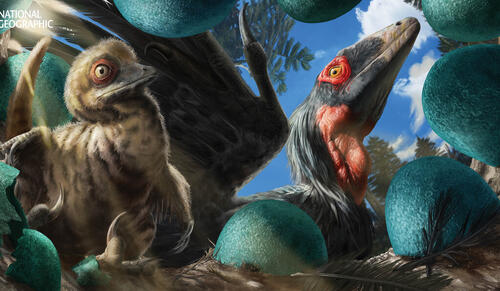
The latest cover of National Geographic magazine features a Yale discovery that stretches back … oh, about 115 million years.
Deinonychus, a Cretaceous Period raptor that Yale paleontologist John Ostrom identified in the 1960s, peers at readers with a menacing eye while guarding a nest of blue-green eggs. A hatchling covered in feathery fuzz gazes up from below its father, who wields distinctive sickle-shaped claws.
Crowned with feathers, the prehistoric beast makes a fitting — if frightening — cover model for the issue’s lead story, which highlights a few of the latest discoveries by scientists at Yale’s Peabody Museum of Natural History that, like Deinonychus, help us reimagine how dinosaurs looked and lived.
In a seminal 1969 paper, Ostrom described Deinonychus as a nimble, warm-blooded predator — more bird than reptile — challenging the traditional view of dinosaurs as plodding, cold-blooded brutes. The National Geographic story shows that a new generation of Yale paleontologists continues this legacy of groundbreaking work as they illuminate the evolutionary link between dinosaurs and modern birds.
Selected images from the magazine are presented here. For more on the article, which is accessible to Nat Geo subscribers, visit the National Geographic website.